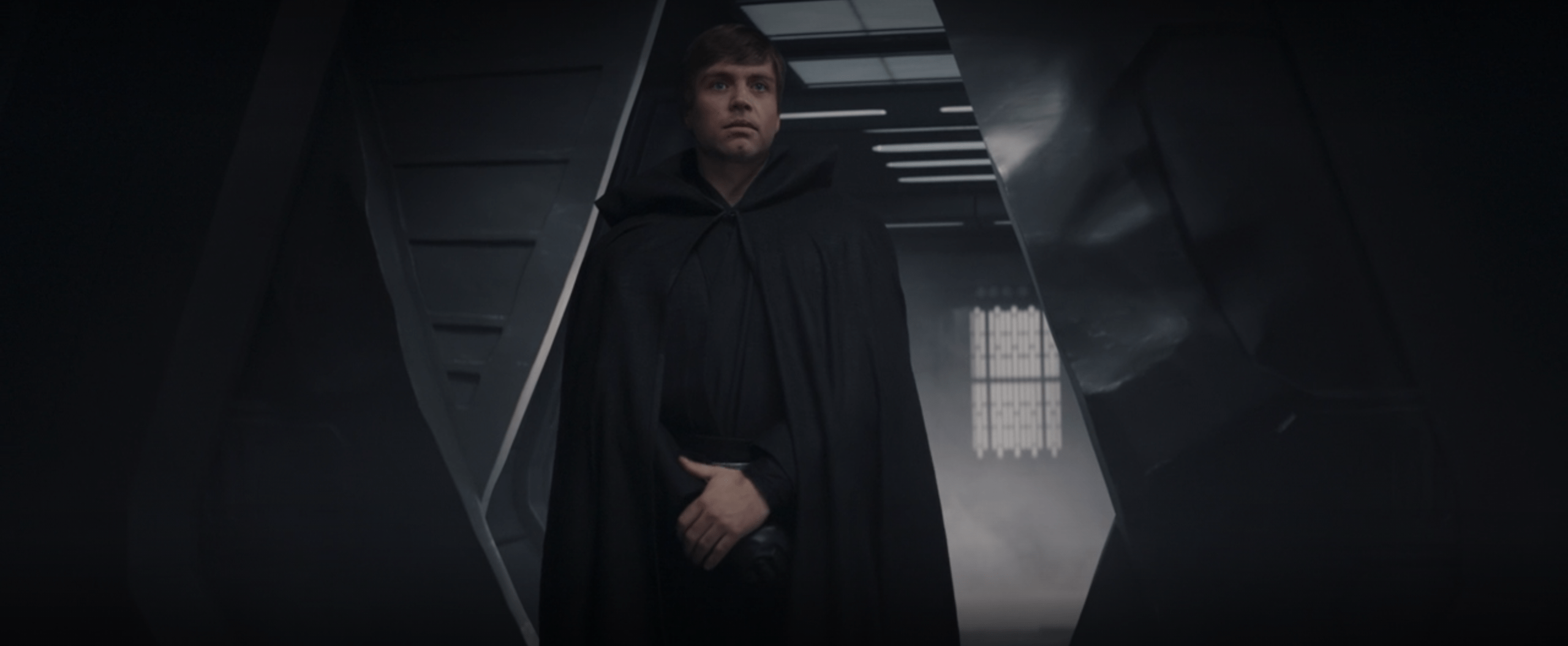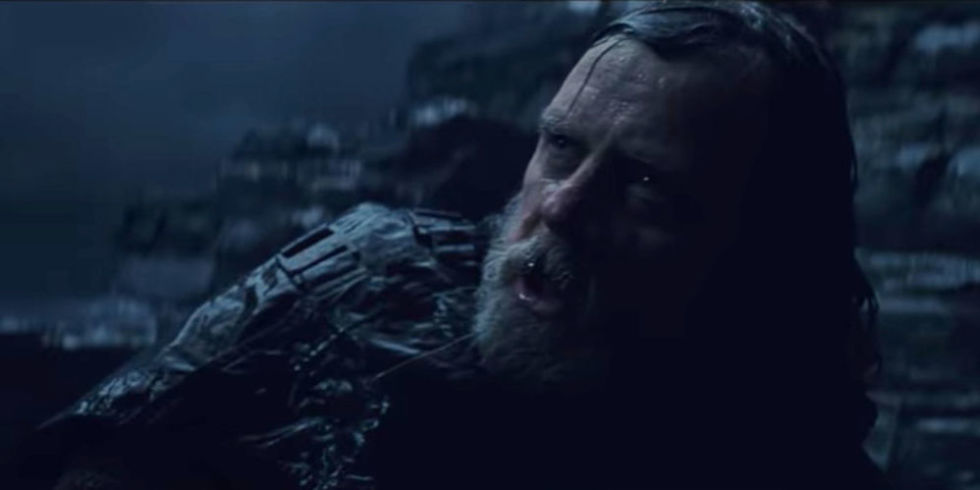Despite the fact that we live in a world with more Star Wars than ever, and even more to come, there is still power in the image of a Jedi. A flowing, hooded cloak, the snap-hiss and surreal glow as their lightsaber pierces our field of view — in spite of decades of familiarity, it’s an image that still sends a shiver down the spine. But it has a power beyond that which makes Star Wars’ future a challenging one.
Several days out from the shocking arrival of Luke Skywalker in The Mandalorian’s second season finale, I’m still trying to parse my frustration and excitement at Star Wars’ most iconic hero entering Din Djarin’s orbit. On the one hand, it feels like a depressing contraction of The Mandalorian and Star Wars’ world, in a season that has relied time and time again on the surprise return of Star Wars characters from films, books, and TV shows, or the tantalising mention of some obscure bit of lore. A CG-enhanced facsimile of times gone by, made to burn into our mind that we cannot simply let these legends grow old and go into our past, that there must always be a chance for these characters to be forever slotted into new stories.
The weaponization of that powerful image of Luke Skywalker, Jedi Knight, as a tool to repeatedly stoke our nostalgia, is a reminder that Star Wars will forever be fond of its insular past, even as it tries to drag itself into an increasingly expansive world.
[referenced id=”1659909″ url=”https://gizmodo.com.au/2020/12/how-the-mandalorians-finale-reveal-fits-into-star-wars-timeline/” thumb=”https://gizmodo.com.au/wp-content/uploads/2020/12/22/mnrre3ben4s10v3ylris-300×169.png” title=”How The Mandalorian’s Finale Reveal Fits Into Star Wars’ Timeline” excerpt=”The Mandalorian’s season finale took Din Djarin’s small slice of the Star Wars universe and exploded it into smithereens — smithereens with much larger ties to the vast Skywalker Saga than any of us could’ve imagined when this show first started last year. But now that its adventures are inextricably…”]
On the other hand, he’s Luke Skywalker, and he’s here to rescue us. OK, sure, he’s here to rescue Grogu, but still.
Even the most sceptical among us cannot deny the visceral thrill of witnessing Luke at his apex here — so soon after the events of Return of the Jedi, being the hero the galaxy seemingly fated him to be. A voice called out for help, and so he came, an X-Wing soaring through space and an emerald blade slicing through foes. A knight not in shining armour, but of shining countenance, warm and loving, and immediately ready to not just train Grogu in the ways of the Force, but to give his life for him. This is Luke at his most luminous, as powerful as he is compassionate, the hero that would spark thousandfold legends. It is the Luke we have always dreamed of when we imagined him, the brightest dawn after the darkest twilight of the Jedi’s downfall. Here, the weapon of a Jedi is not martial strength or a glowing sword, but of peace and hope, the heroism at the heart of what makes Star Wars so enchanting as a fantasy in the first place.

For all my mixed feelings, one thing is clear about the Luke we watched in awe last week slicing through Dark Troopers like a hot knife through butter: He’s not the Luke we’ve come to know in recent Star Wars storytelling.
This is obvious, of course: this Luke is younger, The Mandalorian is decades before the events of the recent sequel movies. This is not the broken, haunted Jedi Master that Rey found on Ahch-To in The Last Jedi, the man who had faced great trauma and the weight of expectation built into the mythos, prophecy, and legend around him, and found himself tragically wanting. The man who, almost in spite, would turn to Rey and ask her if he was meant to come rolling along on his own, laser sword in hand, to cut down the First Order and solve all her problems — a line with added venom now, given that this is exactly the sort of thing Luke once thought was his burden to do. This is the man who will become that, and most crucially we cannot have one without the other.
The Mandalorian gives us the great height that Luke must one day fall from by the time of The Last Jedi, and the context it gives us only makes that fall, and his eventual rise from it, all the more potent. They are texts in concert with each other, even as one plays so heavily on nostalgic charm as the other seeks to challenge that nostalgia with a sense of profoundly human vulnerability.

But while in the Star Wars universe this makes sense chronologically, in our own chronology, Luke’s Mandalorian appearance comes in the context of what has now been three years of back and forth anger and debate over Luke’s characterization in The Last Jedi. Fans who felt betrayed that their hero would not simply show up as he had in Return of the Jedi, sabre in hand, to save the Resistance now had the image they wanted on the small screen — a young Luke, a powerful Luke, being the hero they wanted but could not find in him as an older man.
Yes, thematically, Luke’s appearance here works in tandem with his “earlier” appearance in The Last Jedi, these two versions are part of the same, long-stretching arc, of course. But it must also carry the weight of the wider context in which new Star Wars material is releasing now: a franchise that ceaselessly reckons with stoking the nostalgic charms of its past stories while trying to move itself forward. A franchise that has found itself, especially around The Last Jedi’s release, at the forefront of a culture war between a diversifying fanbase and toxic gatekeepers who don’t want their stories played with, their heroes challenged.
For the powers behind a cultural force like Star Wars, wielding the potent image of Luke Skywalker in this context is a dangerous, delicate game. The intent to contextualise some of the franchise’s boldest characterizations — bold manoeuvres it’s seemingly desired to shirk from in the years since, even as it’s in conversation with them — must be tempered with hindsight that Star Wars’ relationship with its own past is endlessly in flux, as captivating as it is frustrating.

The Luke Skywalker of The Mandalorian might be fine with being a weapon wielded in this way, with good intentions to bring hope to those who see his heroics. The Luke Skywalker of The Last Jedi, embittered and sceptical of the mythos hung around his neck, would probably react in much the same way as he did to Rey on that rainy night on Ahch-To. But if Star Wars is to keep leveraging the nostalgia of its past as it tries to expand outward and forward, the weaponization of its most powerful images is going to be a tool fraught with danger.
Editor’s Note: Release dates within this article are based in the U.S., but will be updated with local Australian dates as soon as we know more.
